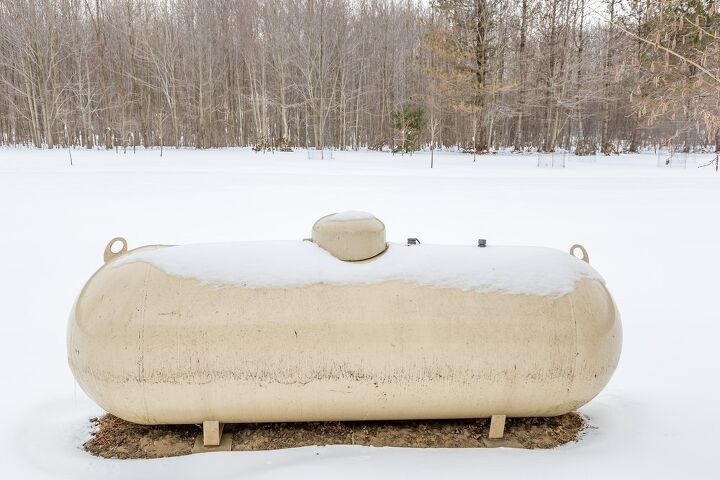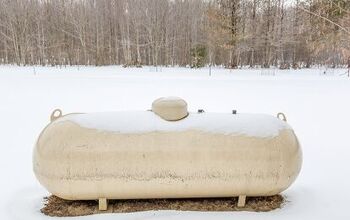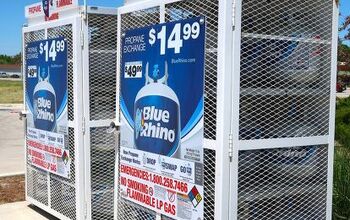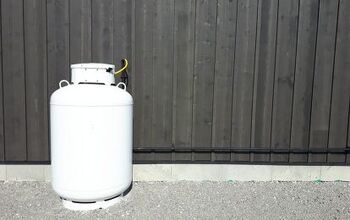Why Is My Propane Tank Freezing? (Find Out Now!)

The best thing about fire is that it provides not just light but warmth. Thanks to propane, you are able to create your own warmth without the need to light an actual fire. Unfortunately, sometimes you cannot get the heat you need because your propane tank has frozen over.
There are two main causes for a propane tank freezing. You may have too high of a humidity level, or a regulator that’s feeding propane quickly. Fortunately, these are not dangerous symptoms, and easy problems to avoid with regular, simple maintenance.
By keeping your propane tank in the proper location and elevation, you can keep it running smoothly. Checking it regularly for frost and sweeping off ice and snow with a broom can also help. Of course, serious situations may call for the help of a professional.
Do You Need Water or Fuel Tank Installation or Replacement?
Get free, zero-commitment quotes from pro contractors near you.

What Is Propane?
Propane keeps your heaters going, heats your water, and even dries your clothes in the dryer. Before propane comes out of your tank, it rests inside as a liquid. As it is being released, it comes to a boil and then turns to the gas state we all recognize.
However, certain situations like extreme temperatures can cause pressure changes, icing on regulators, and ultimately, a frozen tank.
What Does A Propane Tank Do?
Propane is a nontoxic and colorless gas that is typically compressed and stored as a liquid in a tank. While it is virtually odorless, manufacturers add a special odor so that people can easily detect it. People mainly use propane for heating, cooking, and engine fuel.
Furthermore, propane is a preferred choice for daily usage because it is economical, reliable, clean-burning, and better for the environment than other fuels. Propane tanks store propane until it you need to use it. Tank sizes range greatly from portable containers to tanks that can hold thousands of gallons.
How Do Propane Tanks Work?
While primarily used as a gas, you always store it in a tank as a liquid. Propane tanks use regulators to pressurize propane that is released to meet the need of the appliance it is powering. This regulation is important as it prevents damage to appliances and consequential accidents.
Propane converts from its liquid form to gas by absorbing heat. The propane tank absorbs heat through pressurization. This pressurization of the liquid propane brings it to a boil until it becomes a gas.
What Causes Propane Tanks to Freeze?
While in the tank, the propane rests as a liquid. When it’s time for usage, the liquid propane must be converted to a gas, a conversion done via an endothermic process. Endothermic processing just means the liquid propane needs heat for you to use it as a gas.
Liquid propane must reach -44 degrees as it leaves the tank and boil to return to its gaseous state. During this process, the pressure in the tank is consistently dropping, and the process pulls heat from the tank’s surroundings. However, in extremely cold temperatures, the pressure can change too drastically.
Drastic pressure changes affect the propane’s ability to move through the conversion process. Ultimately, this is when icing appears on your tank, valve, or regulator. A frozen regulator will stop your tank’s functioning and leave you with low to no gas flow.
As liquid propane returns to a gaseous state, freezing the surrounding humidity is normal. Conversely, sometimes the propane can freeze itself in its liquid state as it passes through the regulator. This typically happens when the process completes too fast.
Are There Other Causes Of Propane Tanks Freezing?
If the process occurs too fast, this can also cause some frost. When changing from liquid to gas, the tank’s cylinder walls heat up to avoid large pressure fluctuations. The faster the propane draw, the less time the tank can heat its walls.
The inside temperature and pressure drop when a tank fails to pull enough energy to heat its walls. Drops in pressure and temperature can prevent the propane from converting to gas. When the propane itself freezes and remains a liquid as it passes through the regulator, the tank frosts.
An overfilled tank can also prevent the endothermic process. Overfill takes away space that is needed for the propane to boil from a liquid to gas. This is why the fixed liquid level gauge is important.
How Do I Prevent My Propane Tank From Freezing?
To prevent your propane tank from freezing, watch the fixed liquid level gauge to make sure you do not overfill. The gauge should warn you when you are exceeding the 80-percent fill capacity. Keep your tank properly filled, especially during cold weather.
Sweep off any ice or snow with a broom, and wrap your tank with an electric blanket. When you do this, make sure to leave the regulator and valve exposed. You can also use a propane regulator cover (bought online).
Another way to prevent freezing is to elevate your tank on a pedestal or another stable platform. You can also elect to upgrade your propane tank to a larger size. If you see ice or snow in the vents or need additional advice, be sure to contact a professional.
What Do I Do If My Propane Tank Is Already Frozen?
Preventing a frozen tank is best, and if you follow the above advisories, you can do just that. Unfortunately, if you already have a frozen propane tank, preventative measures might not help. Discontinue using the tank so it can absorb more heat and wait for the frost to melt away.
You can also try to reposition your tank as designed for use or disconnect the regulator, letting it thaw.
You should also check your fixed liquid level gauge for good measure. If your gauge indicates an overfill, close the tank, and contact your propane company. You should not attempt to remedy an overfill by yourself.
What Is The Best Propane Tank Size?
You should determine your propane tank size by home size, type of appliances, and geographic region and climate. There are two common types of propane tanks: ASME tanks and DOT cylinders. Which tank you use depends primarily on whether you are using propane for home or business purposes.
American Society of Mechanical Engineers (ASME) tanks hold 20-1,000 gallons of propane and are common for fueling homes. Department of Transportation (DOT) cylinders, also called stationary or exchange service cylinders, tend to be smaller than ASME tanks. DOT cylinders are more common for work and recreation purposes.
The size of a tank heavily relies on need; for instance, you can use portable tanks for grills and camping. On the other hand, larger tanks are best for homes, but larger tanks require careful installation, filling, and maintenance. While all tanks require a certain level of precaution, safety is more critical with larger tanks.
What Are Propane Tank Regulations?
ASME tanks must be painted using a reflective color and display the manufacturer’s nameplate. Tanks that do not meet these ASME guidelines will not be filled. There are also local codes and state regulations that must be adhered to when installing an ASME tank.
Liquid propane must reach -44 degrees during the conversion process. Temperatures above this threshold will halt the process. Propane that fails to convert to gas is virtually useless.
How Is Propane Pressure Delivered?
Pressure delivery occurs using three critical elements: the restricting, loading, and measuring elements. The restricting element has an adjusting valve, while the loading element involves a spring, piston, or diaphragm actuator. Finally, the measuring element balances the pressure from the inlet and outlet.
All approved propane tanks must also have a standard set of valves. This includes the attaching valve, which connects the hose and tank, and vapor return valve, regulating the pressure within limits. There’s also a service valve, relief valve, and liquid withdrawal valve.
While the service valve converts propane from liquid to gas, the liquid withdrawal valve withdraws the correct amount. The relief valve helps bleed off pressure, especially in emergencies. There are also required gauges.
An operative propane tank must have two types of gauges, the float gauge and the fixed liquid level gauge. The float gauge shows how much propane remains in the tank. The fixed liquid level gauge lets you know when the level is too high and will lead to overfill.
Do You Need Water or Fuel Tank Installation or Replacement?
Get free, zero-commitment quotes from pro contractors near you.

Related Questions
Does the weather affect my propane tank?
While in the tank, the propane rests as a liquid until it converts into a gas. The liquid propane must reach -44 degrees in order for it to boil. This means If the surrounding temperature is too cold, the propane remains in its unusable liquid form.
How often should I replace my propane tank regulator?
Regulators, like most things we rely on daily, are subject to wear and tear. A regulator can last an average of 15 years, but some regulators can last 25 years. Eventually, you must replace regulators, and industry professionals confirm this timeline.
Will a propane tank explode if frozen?
No. Frost on your tank, regulators, or valves is nothing to worry about. Frost will not cause your tank to explode, implode, or rupture.

Stacy Randall is a wife, mother, and freelance writer from NOLA that has always had a love for DIY projects, home organization, and making spaces beautiful. Together with her husband, she has been spending the last several years lovingly renovating her grandparent's former home, making it their own and learning a lot about life along the way.
More by Stacy Randall



























